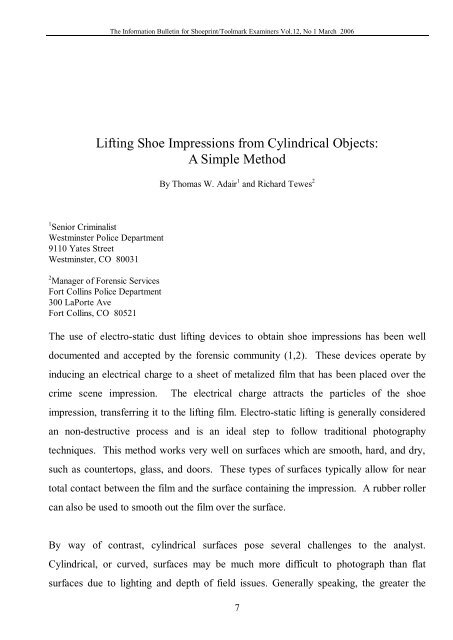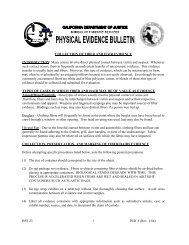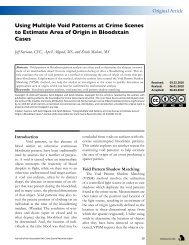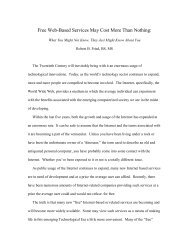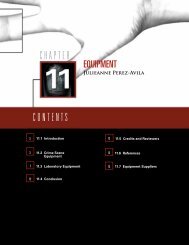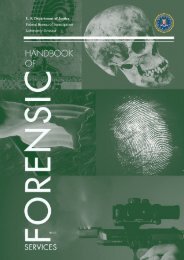Lifting Shoe Impressions from Cylindrical Objects - Crime Scene ...
Lifting Shoe Impressions from Cylindrical Objects - Crime Scene ...
Lifting Shoe Impressions from Cylindrical Objects - Crime Scene ...
You also want an ePaper? Increase the reach of your titles
YUMPU automatically turns print PDFs into web optimized ePapers that Google loves.
The Information Bulletin for <strong>Shoe</strong>print/Toolmark Examiners Vol.12, No 1 March 2006<br />
<strong>Lifting</strong> <strong>Shoe</strong> <strong>Impressions</strong> <strong>from</strong> <strong>Cylindrical</strong> <strong>Objects</strong>:<br />
A Simple Method<br />
1 Senior Criminalist<br />
Westminster Police Department<br />
9110 Yates Street<br />
Westminster, CO 80031<br />
2 Manager of Forensic Services<br />
Fort Collins Police Department<br />
300 LaPorte Ave<br />
Fort Collins, CO 80521<br />
By Thomas W. Adair 1 and Richard Tewes 2<br />
The use of electro-static dust lifting devices to obtain shoe impressions has been well<br />
documented and accepted by the forensic community (1,2). These devices operate by<br />
inducing an electrical charge to a sheet of metalized film that has been placed over the<br />
crime scene impression. The electrical charge attracts the particles of the shoe<br />
impression, transferring it to the lifting film. Electro-static lifting is generally considered<br />
an non-destructive process and is an ideal step to follow traditional photography<br />
techniques. This method works very well on surfaces which are smooth, hard, and dry,<br />
such as countertops, glass, and doors. These types of surfaces typically allow for near<br />
total contact between the film and the surface containing the impression. A rubber roller<br />
can also be used to smooth out the film over the surface.<br />
By way of contrast, cylindrical surfaces pose several challenges to the analyst.<br />
<strong>Cylindrical</strong>, or curved, surfaces may be much more difficult to photograph than flat<br />
surfaces due to lighting and depth of field issues. Generally speaking, the greater the<br />
7
The Information Bulletin for <strong>Shoe</strong>print/Toolmark Examiners Vol.12, No 1 March 2006<br />
curvature of the object, the greater the difficulty the analyst will likely encounter during<br />
the documentation process. In addition, traditional lifting techniques may not be well<br />
suited for curved surfaces. The inability to properly secure lifting film over the<br />
impression area may lead to slippage and subsequent damage or distortion to the<br />
impression while rolling. The inability to make near total contact between the lifting film<br />
and the impression may also lead to undesirable gaps or wrinkles in the film. These<br />
difficulties are significantly increased when the curved surface is soft and flexible.<br />
In the Winter of 2005 the senior author was reviewing photographs <strong>from</strong> a burglary scene<br />
when he observed a shoe impression on a section of foam pipe insulation (figure 1).<br />
Patrol officers had responded to the scene and taken photographs but had not seen the<br />
shoe impression on the foam. The foam insulation was located in the ceiling of a<br />
commercial business near the point of forced entry on the roof. Patrol officers did not<br />
collect the foam and the object was subsequently discarded by the property owner soon<br />
after.<br />
The challenge of lifting a shoe impression <strong>from</strong> a “soft” or flexible curved object was<br />
very intriguing. Even though the crime scene evidence was not submitted for<br />
examination, the authors decided to replicate the evidence and attempt a recovery of the<br />
shoe impression in an experiment. The authors obtained standard 2 ¼” foam insulation<br />
strips typically used to insulate copper water pipes. Several dusty shoe impressions were<br />
made with various mediums such as dirt, carpet dust, and drywall dust. The impressions<br />
were placed on the foam in various orientations by stepping on the foam as if walking. A<br />
Sirchie model ESP900 electro-static lifting device was used for all experiments. It was<br />
observed that the main difficulty in obtaining impressions with electro-static film on<br />
curved surfaces was in the application of the film to the object containing the shoe<br />
impression. It was therefore hypothesized that better results might be obtainable by<br />
reversing the approach and applying the object to the lifting film.<br />
8
The Information Bulletin for <strong>Shoe</strong>print/Toolmark Examiners Vol.12, No 1 March 2006<br />
Photographs of the impressions on the test foam were taken prior to lifting attempts<br />
(figure 2). The quality of the photographs, for examination purposes, was poor. This<br />
was in part due to the lack of contrast between the impression and the background, the<br />
texture of the background, and the difficulty experienced in achieving even oblique<br />
lighting. A sheet of lifting film was secured to a flat countertop with the metalized<br />
(silver) side down. The corners of the film were secured with “safe release” Scotch<br />
brand masking tape. The lifting device was placed as it normally would be on the edge<br />
of the film with a grounding plate. The unit was turned on and the foam section was<br />
“rolled” once over the film with light pressure <strong>from</strong> the sides (figure 3). Pressure was not<br />
applied to the areas of the foam containing the impression. Figure 4 shows excellent<br />
results of a single pass onto the lifting film. Measurements of the subsequent lifted<br />
impression were compared with the original impression (on the foam) with no significant<br />
distortion observed.<br />
<strong>Crime</strong> scene analysts rarely encounter footwear impressions on cylindrical objects. In<br />
most crime scenes, two dimensional impressions are typically found on smooth, hard<br />
surfaces such as floors, counters, doors, or glass. Occasionally however, analysts may<br />
encounter impressions contained on cylindrical objects such as bottles, baseball bats,<br />
handrails, or in this case, insulated pipe foam. These impressions can be very<br />
challenging to document and collect using traditional methods of photography and<br />
electro-static lifting due to the physical curvature of the object containing the impression.<br />
While the need for this lifting method may remain rare in general crime scene processing<br />
examiners should consider this method when faced with movable cylindrical or curved<br />
surfaces.<br />
References<br />
9
The Information Bulletin for <strong>Shoe</strong>print/Toolmark Examiners Vol.12, No 1 March 2006<br />
1. Bodziak, W.J. 1995. Footwear Impression Evidence. CRC Press, Boca Raton<br />
FL. 421 pps.<br />
2. Cassidy, M.J. 1995. Footwear Identification. Lightning powder Company.<br />
Salem, OR. 176 pps.<br />
10
The Information Bulletin for <strong>Shoe</strong>print/Toolmark Examiners Vol.12, No 1 March 2006<br />
11
The Information Bulletin for <strong>Shoe</strong>print/Toolmark Examiners Vol.12, No 1 March 2006<br />
12
The Information Bulletin for <strong>Shoe</strong>print/Toolmark Examiners Vol.12, No 1 March 2006<br />
13


